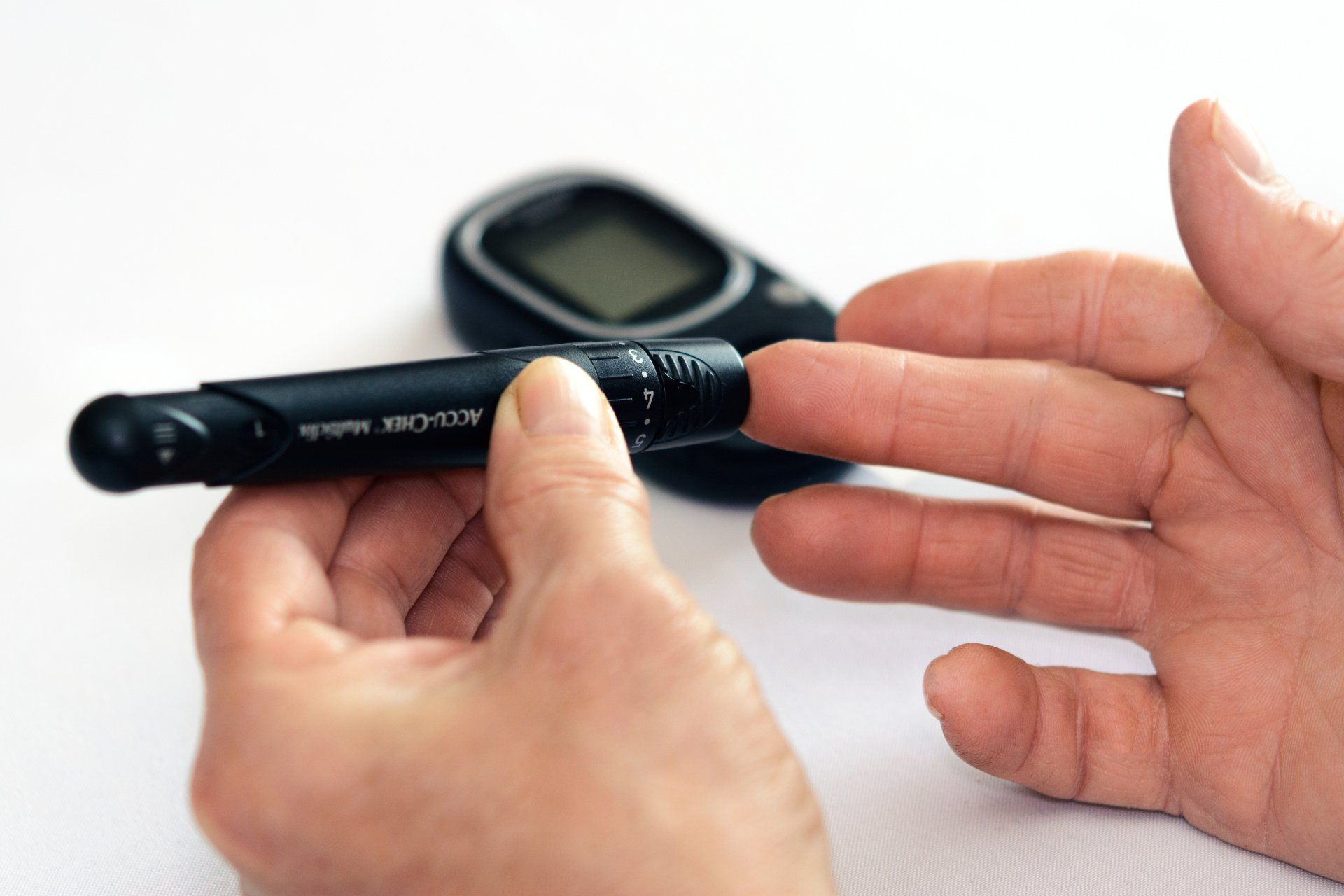Blog

Safe Exercise for People with Hypermobility Ehlers-Danlos Syndrome (hEDS) If you’ve been diagnosed with hypermobility Ehlers-Danlos Syndrome (hEDS) , you know that movement can feel tricky. Joints may slip, ache, or feel unstable, and sometimes exercise feels intimidating and overwhelming. However, the right kinds of exercise will help you get stronger, protect your joints, and improve your daily comfort. The goal with hEDS is not to push your body to extremes—it’s to gradually, over time, build gentle strength, stability, and confidence. Why Exercise Matters with hEDS The right types of movement can: Strengthen muscles that support loose joints. Improve balance and body awareness (reducing injury risk). Ease pain and fatigue. Boost mood and energy. Nurse Pro Tip : Think “support” not “stretch.” The goal isn’t more flexibility—you already have plenty—but stability and protection. ✅ Safe & Helpful Exercises When choosing activities, think slow, steady, and supportive. 💧 Water-Based Exercise Swimming, water walking, or gentle aquatic therapy take pressure off your joints while still giving you resistance to build strength. 🧘 Modified Pilates or Yoga Focus on core strength and stability. Skip deep stretches—keep movements small, controlled, and steady. 🏋️ Light Strength Training Resistance bands or light weights help build protective muscle. Stick with lighter loads, higher reps, and slow, intentional movements. 🚶 Walking or Cycling Flat-ground walking and recumbent cycling are gentle, low-impact ways to support cardiovascular health. 🤲 Physical Therapy Exercises A physical therapist who understands hEDS can teach you safe, customized strengthening routines to stabilize your most vulnerable joints. ( Email me @ yourinspiredvitality@gmail.com for personalized recommendations or referrals to Utah PTs familiar with hEDs). ❌ Exercises to Avoid Some activities can increase the risk of injury or worsen symptoms. It’s best to avoid: High-impact sports (running, jumping, contact sports). Heavy weightlifting (places too much strain on joints). Deep stretching or “contortion-like” yoga. Fast-paced HIIT workouts with explosive movements. Gymnastics or flexibility-focused training. Nurse Pro Tip : If the focus of a workout is “how far you can stretch” or “how heavy you can lift,” it’s probably not the right fit for hEDS. 💡 Tips for Moving Safely Listen to your body—stop if something feels wrong. Prioritize stability, not flexibility. Work with professionals who understand hypermobility. Progress slowly—small, consistent steps are safest. ✨ The Bottom Line -- Living with hEDS doesn’t mean avoiding exercise. It means finding the right kind of movement that supports your body instead of stressing it. With gentle, strengthening exercises, you can feel stronger, reduce pain, and enjoy a more active, confident life.

Mold Illness vs. Allergies: What’s the Difference? When people think of mold, they often assume it just causes seasonal allergies—sneezing, itchy eyes, and runny noses. But mold illness goes far beyond typical allergic reactions, affecting multiple systems in the body and often mimicking chronic or autoimmune conditions. Mold Allergies: The Basics Mold allergies are an immune response to mold spores. Symptoms may include: Sneezing Runny or stuffy nose Itchy, watery eyes Cough or post-nasal drip Mild fatigue These symptoms usually flare up in humid environments, basements, or during seasonal changes. They’re often treated with antihistamines or allergy shots. Mold Illness: A Deeper Toxic Load Mold illness, also known as Chronic Inflammatory Response Syndrome (CIRS) , is triggered not by an allergic reaction, but by a toxic overload from mycotoxins —dangerous chemicals produced by certain molds . These toxins can accumulate in your body, especially if your detox pathways are compromised. Symptoms may include: Brain fog Chronic fatigue Digestive issues Hormonal imbalances Neurological symptoms like anxiety or depression Joint and muscle pain Key Differences Mold Allergy Mold Illness (CIRS) Involves histamine reaction Involves chronic inflammation Symptoms are seasonal or triggered by exposure Symptoms persist and worsen over time Usually treatable with OTC meds Requires detox, lifestyle changes, and medical treatment What If You Have Both? Some people suffer from both mold allergies and mold illness, making symptoms even more complex. If you’ve been treating allergies with little to no relief, it may be time to explore the possibility of deeper toxicity. If you have both mold allergies and mold illness, you will have to treat both. Remediate all mold out of your environment. Test for the presence of mold in your home and office environments. Remove high mold foods from your diet. What to Do Next If your symptoms go beyond allergy season and don’t improve with standard treatments, it’s time to consider mold testing and a functional approach to healing. At Your Inspired Vitality, we specialize in identifying and treating mold illness holistically. Detoxification strategies (sauna therapy, sweating, supplements, and binders), as well as dietary and environmental changes can help. Testing for the presence of specific mycotoxins is important to do as well and can be done through a simple urine test. Ready to feel better? Book a consultation today and let’s find out what’s really behind your symptoms.

Is Mold Making Me Sick? Common Symptoms & What to Watch For Mold exposure is more than just an allergy trigger—it can be a root cause of chronic illness that is often overlooked. If you’ve been experiencing persistent symptoms without a clear diagnosis, mold might be the missing piece of the puzzle. Let’s explore the most common signs of mold illness and how to determine if your environment is making you sick. Common Symptoms of Mold Illness Mold illness, also known as Chronic Inflammatory Response Syndrome (CIRS), can affect multiple systems in the body. Here are some of the most frequently reported symptoms: 1. Respiratory Issues– Chronic sinus congestion, shortness of breath, wheezing, or a persistent cough can indicate mold exposure. 2. Brain Fog & Cognitive Issues – Difficulty concentrating, memory problems, and confusion are common in mold toxicity. 3. Fatigue & Weakness – If you feel exhausted despite adequate rest, mold-related inflammation may be depleting your energy. 4. Skin Reactions – Unexplained rashes, itching, or increased sensitivity to chemicals could be linked to mold exposure. 5. Digestive Problems – Nausea, bloating, diarrhea, or irritable bowel syndrome (IBS) symptoms can be triggered by mold. 6. Muscle & Joint Pain – Widespread body aches, stiffness, and inflammation may indicate mold-induced toxicity. 7. Mood Changes – Anxiety, depression, or increased irritability can result from mold-related neuroinflammation. 8. Increased Sensitivity to Light, Sound, and Smells – Mold can affect the nervous system, making you more sensitive to stimuli. How to Determine If Mold is Making You Sick - Evaluate Your Environment – Have you noticed symptoms worsen at home, work, or school? Musty odors, water damage, or visible mold growth are red flags. - Track Your Symptoms – If symptoms improve when you leave a certain space for an extended period, mold may be a contributing factor. - Consider Testing – Mold illness isn’t always obvious on standard medical tests. Specialized urine mycotoxin tests and inflammatory marker panels can help confirm exposure. Next Steps: What You Can Do If you suspect mold is impacting your health, here’s what you can do: - Schedule a consultation for mold illness testing and a personalized treatment plan. - Take steps to assess and remediate mold in your environment. - Begin supporting your body’s detox pathways with proper nutrition, binders, and lifestyle changes. Ready to Get Answers? At Your Inspired Vitality, we specialize in identifying and treating mold-related illnesses. If you suspect mold exposure is affecting your health, contact us today to schedule a consultation and start your healing journey.

Natural Treatments for Hashimoto’s Thyroiditis: A Holistic Approach Hashimoto's thyroiditis, also known as autoimmune thyroiditis, is a condition where the immune system mistakenly attacks the thyroid gland, leading to chronic inflammation and, over time, impaired thyroid function. Practicing as a holistic, integrative nurse practitioner in Provo, Utah, I often encounter patients seeking natural treatments for Hashimoto’s to complement conventional care. Individualized treatment is crucial. Several natural protocols have shown promise in managing this condition. Below, I outline some of the most effective holistic approaches, including iodine protocols, castor oil packs, essential nutrients and supplements, treating underlying infections, and the importance of a gluten-free diet. 1. Iodine Protocols Iodine is essential for thyroid function, as it plays a critical role in the synthesis of thyroid hormones. While iodine deficiency contributes to thyroid dysfunction, excessive iodine intake may, in very rare cases, exacerbate autoimmune activity in the thyroid. Therefore, it’s important to approach iodine supplementation cautiously. For patients with Hashimoto’s, I offer and recommend an iodine loading test to determine baseline levels before starting supplementation. If deficiency is confirmed, low-dose iodine supplementation can be considered, typically in combination with selenium. Selenium is crucial because it helps mitigate the inflammatory detoxing effects from iodine supplementation. We carefully titrate based on the patient’s response and lab results. 2. Castor Oil Packs Castor oil packs are a time-honored remedy in holistic medicine, valued for their anti-inflammatory and detoxifying properties. When applied over the thyroid gland, castor oil packs can help reduce inflammation and support lymphatic drainage, which can be very beneficial for patients with Hashimoto’s. The castor oil packs and castor oil I have found to be of the highest quality are available at the following link: https://www.shopqueenofthethrones.com/ Many patients report reduced neck pain and swelling, as well as an overall sense of well-being with regular use. 3. Essential Vitamins and Nutrients Several vitamins and minerals play a pivotal role in supporting thyroid health and modulating the immune system. Key nutrients to consider include: Vitamin D : Low levels of vitamin D have been linked to an increased risk of autoimmune diseases, including Hashimoto’s. Supplementation with vitamin D3 can help modulate immune function and reduce autoimmune activity. A typical dose ranges from 2,000 to 5,000 IU daily, depending on the patient’s blood levels. The best way to get Vitamin D is through your skin from the sun. In Utah, we are so far north of the equator that many people are deficient year round, and may need sun exposure + supplementation. I test all of my patients' Vitamin D levels routinely. B Vitamins : B vitamins, particularly B12, are essential for energy production and neurological function. Many patients with Hashimoto’s are found to be deficient in B12, which can contribute to fatigue and cognitive symptoms. Supplementation with a high-quality B-complex can support overall thyroid function and energy levels. I also test for the MTHFR gene to see if you need methylated B vitamins. Magnesium : Magnesium is involved in hundreds of biochemical reactions in the body, including those related to thyroid hormone production and utilization. It also supports adrenal health, which is often compromised in patients with chronic autoimmune conditions. Magnesium glycinate or citrate are well-absorbed forms that can be taken daily. Zinc and Selenium : Both of these minerals are crucial for thyroid hormone synthesis and immune regulation. Selenium, as mentioned earlier, is particularly important when supplementing with iodine, while zinc supports immune function and may help reduce thyroid antibody levels. 4. Treating Underlying Infections Chronic infections, such as Epstein-Barr virus (EBV), Lyme disease, and intestinal dysbiosis, have been implicated in the onset and exacerbation of autoimmune thyroiditis. Identifying and addressing these underlying infections is a critical component of a holistic treatment plan. For example, if EBV is suspected, antiviral herbs in combination with generalized immune system support may be beneficial. In cases of intestinal dysbiosis, a comprehensive gut-healing protocol, including probiotics, prebiotics, and digestive enzymes, can help restore balance to the microbiome and reduce systemic inflammation. Functional medicine testing can be useful in identifying these hidden infections, allowing for targeted treatment that addresses the root cause of the autoimmune response. 5. Gluten-Free Diet A gluten-free diet is often recommended for patients with Hashimoto’s thyroiditis, as gluten has been shown to trigger autoimmune responses in susceptible individuals. This is particularly true for those with celiac disease or non-celiac gluten sensitivity, both of which are more prevalent in people with Hashimoto’s. Eliminating gluten from the diet can reduce inflammation, improve gut health, and lower thyroid antibody levels. Many patients report significant improvements in symptoms such as fatigue, brain fog, and digestive issues after adopting a gluten-free diet. In addition to avoiding gluten, it’s beneficial to focus on a nutrient-dense diet rich in anti-inflammatory foods, such as leafy greens, fatty fish, nuts, seeds, and berries. Reducing the intake of processed foods, refined sugars, soy, caffeine, and dairy can also support thyroid health and overall well-being. Conclusion Managing Hashimoto’s thyroiditis requires a comprehensive and individualized approach. By integrating the use of castor oil packs, essential vitamins, minerals, and supplements, going on a gluten free diet, and treating underlying infections, patients can significantly improve their thyroid function and overall quality of life. My goal is to empower my patients with the tools and knowledge they need to take control of their health, addressing not just the symptoms but the root causes of their condition.

Welcome to the gut health series! This week, I'll discuss with you how nutrition and diet play a crucial role in maintaining a healthy gut. Your gut is home to trillions of bacteria that help with digestion, nutrient absorption, and immune system function. Your gut creates neurotransmitters and affects your mood too. You should, actually, trust what your gut is telling you! The Gut Microbiome: Your Digestive Allies Your gut microbiome consists of a vast community of microorganisms that live in your digestive tract. These bacteria, viruses, and fungi play a key role in breaking down food, producing vitamins, and protecting against harmful pathogens. A balanced diet can help maintain a healthy and diverse gut microbiome, which is essential for overall health. The more good bugs you have, and the more types of good bugs you have, the better you will feel. Fiber: The Gut's Best Friend Fiber is one of the most important nutrients for gut health. It acts as food for the beneficial bacteria in your gut, helping them thrive and produce short-chain fatty acids (SCFAs) that support gut lining integrity and reduce inflammation. There are two types of fiber: soluble and insoluble. Soluble Fiber: Found in foods like oats, beans, fruits, and vegetables, soluble fiber dissolves in water to form a gel-like substance. It helps regulate blood sugar levels and lowers cholesterol. (We have to be cautious with certain foods that contain lectins though, like oats and beans, they require special cooking methods, because they can tear up that delicate one celled intestinal lining. More on this in a future blog post). Insoluble Fiber : Found in whole grains, nuts, seeds, and vegetables, insoluble fiber adds bulk to stool and helps it pass more easily through the digestive tract, preventing constipation. (Please refer to Dr. Gundry's books on lectins to learn more). Fermented Foods: Boosting Probiotics Fermented foods are rich in probiotics, which are live bacteria that can confer health benefits when consumed. These foods help replenish and maintain the balance of good bacteria in your gut. Some popular fermented foods include: Yogurt : Contains beneficial bacteria like Lactobacillus and Bifidobacterium (low Bifidobacterium puts you at higher risk for developing COVID-19). Kefir : A fermented milk drink that is a potent source of probiotics. Sauerkraut and Kimchi: Fermented cabbage that provides a variety of beneficial bacteria. Kombucha : A fermented tea rich in probiotics and antioxidants (I do not advise making your own). Prebiotics: Feeding Your Gut Bacteria Prebiotics are non-digestible fibers that feed the beneficial bacteria in your gut. Including prebiotic-rich foods in your diet can enhance the growth and activity of good bacteria. Some excellent sources of prebiotics are: Garlic and Onions : Contain inulin, a type of prebiotic fiber. Bananas: Especially when slightly green, are rich in resistant starch. Asparagus and Artichokes : High in inulin and other prebiotics. Whole Grains : Such as barley, oats, and whole wheat. Avoid these, obviously, if you are gluten free. I recommend for everyone to utilize ancient grains such as Einkorn or Khorasan wheat, both are non hybridized and are more easily digested and better for the body. The brand Jovial Foods makes excellent healthy whole grain products, that even those who are gluten sensitive (but not wheat allergic or Celiac's) can usually tolerate. Hydration: The Unsung Hero Staying hydrated is crucial for maintaining gut health. Water helps dissolve nutrients, aids in digestion, and keeps stool soft, preventing constipation. Aim to drink at least eight glasses of water a day, and more if you're active or live in a hot climate. Avoid tap water whenever possible. Try to drink water that is distilled or has gone through a reverse osmosis process; add back in electrolytes as needed. Drinking from glass is always preferable to drinking out of plastic when possible. Mindful Eating: Savor Your Meals How you eat is just as important as what you eat. Eating mindfully can improve digestion and enhance your gut health. Chew Thoroughly: Chewing breaks down food into smaller pieces, making it easier for your digestive system to process. Eat Slowly : Eating slowly allows your body to recognize when you’re full, preventing overeating. Avoid Distractions : Focus on your meal rather than eating while watching TV, playing on your phone, or working, which can lead to overeating and poor digestion. Foods to Limit: Protecting Your Gut Certain foods can disrupt your gut microbiome and negatively impact your digestive health. Try to limit: Processed Foods: High in unhealthy fats, sugars, and additives that can harm your gut bacteria. The majority of foods found on American grocery shelves are UHPFs (Ultra High Processed Foods). Regular consumption of these foods leads to terrible gut health later. Artificial Sweeteners : Some studies suggest they can disrupt the gut microbiome and lead to digestive issues. Additionally, the brain cannot tell the difference between artificial sweeteners and real sugar, so the dopamine effect is the same and weight gain can be a serious issue, whether you are drinking diet coke or full sugar coke. Alcohol and Caffeine : Excessive consumption can irritate the gut lining and affect digestion. Conclusion A healthy gut starts with what you put on your plate-- eat lots of plants and lots of colors. Don't eat foods your great grandma would not recognize as a food . By including a variety of fiber-rich, fermented, and prebiotic foods in your diet, staying hydrated, and eating mindfully, you can support your gut microbiome and overall digestive health. Remember, small changes in your diet can make a big difference in how you feel. As I like to say, you can pay at the grocery store now, or the pharmacy later - your choice! Next week, I'll discuss supplements that can support your gut health. Stay tuned!

When a migraine hits, finding quick relief is crucial. This week, we're focusing on treatments you can take as soon as you feel a migraine coming on, and we will also briefly discuss Qulipta, which is a newer preventive migraine medication. We’ll highlight Qulipta, Nurtec, Ubrelvy, and also cover the well-known triptans, rizatriptan and sumatriptan. These medications are designed to help you feel better fast. Let's see how they work and what you should know about them. Qulipta: Qulipta is a new medication you take by mouth. It works by blocking a specific molecule that causes migraines. This can help make your migraine less severe and shorter. It helps reduce the frequency and duration of migraines someone has. It is taken daily. Some common side effects are feeling nauseous or tired. To prevent nausea I recommend taking it with food. I have samples available at my office for the right patient to try. Nurtec: Nurtec is another medication that you can take when you have a migraine. It dissolves on your tongue, which means it starts working quickly. It also blocks that pesky molecule responsible for migraines. Side effects might include nausea and a dry mouth. It has a minty aftertaste. Nurtec also has a long half life, meaning some people have more relief from the postdrome of the migraine the 2nd day after they take it than the first day. It is the only rescue medication to come out on the market that worked so well that later the FDA approved it as a preventive migraine medication. For migraine prevention people dissolve one tablet on their tongue every other day. Samples are available in my office. Ubrelvy: Ubrelvy is similar to Nurtec. You take it by mouth, and it works by blocking the same molecule to reduce your migraine pain and other symptoms. Some people might feel nauseous or sleepy after taking it, but it is generally well tolerated. You can take a second dose two hours after the first dose is taken if you still have the migraine. Samples available in my office. Rizatriptan and Sumatriptan: Rizatriptan and sumatriptan belong to a class of medications known as triptans, which are specifically designed to treat migraines. They work by narrowing blood vessels in the brain and reducing inflammation, which helps relieve migraine symptoms. Triptans are not safe for use in people who have had strokes, heart attacks, high blood pressure, or a history of hemiplegic migraines. Rizatriptan : Taken as a tablet or dissolvable wafer, rizatriptan can start working within 30 minutes. Common side effects include dizziness, drowsiness, and dry mouth. Sumatriptan : Available as a tablet, nasal spray, or injection, sumatriptan provides flexible options depending on your preference and the severity of your migraine. Side effects can include flushing, feelings of warmth or tingling, and dizziness. Managing Side Effects While these medications can help a lot, they might also cause some side effects. I typically like to prescribe an anti-nausea medication to use if needed, and will also design migraine cocktails when appropriate. Here are a few tips to handle the common side effects: Stay Hydrated : Drinking plenty of water can help if you're feeling nauseous or have a dry mouth. Rest : Make sure to get enough rest, especially if the medication makes you feel tired. Track Your Symptoms : Keep a journal of any side effects and talk to me about them so I can adjust your treatment if needed. Knowing your options for quick migraine relief and how to manage any side effects can help you take control of your migraines. Always talk to your healthcare provider before starting any new medication. Stay tuned for more tips and information on managing migraines effectively!

Migraines can be a real pain—literally! But did you know there are medications you can take regularly to help prevent them? In this post, I’ll discuss different types of preventive medications that can make a huge difference for those who suffer from frequent migraines. Let's break down what these medications are, how they work, and what side effects you might encounter. It’s also important to note that before insurance will cover injectable medications (such as monthly preventative injections or Botox shots), you will need to try and fail–or have medical contraindications to trying–medications from each of these 3 categories. This is not an all inclusive list. After you have done a trial of medication from each of these first 3 categories insurance will typically cover quarterly Botox shots or monthly injectables including Aimovig, Ajovy, or Emgality. Note that some insurance companies require trials of additional antidepressants such as Effexor etc., and not just tricyclic antidepressants. Category 1: Antiseizure Medications–Topiramate, Gabapentin, and Pregabalin These medications are usually used to treat seizures, but they can also help prevent migraines. They work by calming down the nerve activity in your brain, which can help stop migraines before they start. Some common side effects include feeling dizzy or tired and changes in weight. Category 2: Tricyclic Antidepressants Medications–Amitriptyline and Nortriptyline These are types of antidepressants, but they can also be used to prevent migraines. They work by balancing certain chemicals in the brain that affect pain. You might experience a dry mouth, feel sleepy, or notice some weight gain when taking these. Category 3: Blood Pressure medications–Propranolol and Verapamil These medications are typically used to lower blood pressure, but they can also help with migraines. They relax your blood vessels, improving blood flow and reducing the chances of a migraine. Some side effects could be feeling tired, dizzy, or having lower blood pressure. Monthly Injectable Medications: Ajovy, Aimovig, and Emgality These are newer migraine prevention treatments. They work by blocking a molecule that triggers migraines. You take them as injections, and they can significantly reduce how often you get migraines–most patients see a 50% reduction in monthly migraines! Common side effects include injection site reactions (redness, itching) and more rarely constipation. Understanding these preventive options can help you manage your migraines better. In next week's post, I'll talk about quick-relief rescue treatments for migraines, including triptans ( Sumatriptan, Rizatriptan ) and gepants ( Nurtec, Ubrelvy ), and how to handle their side effects. We will also discuss Qulipta in the next post.

Welcome back to our neuropathy awareness series! In this week's blog post, we'll discuss the various treatment options available for managing neuropathy. While medications play a crucial role in symptom management, there are plenty of alternative and complementary therapies that can provide relief and improve overall nerve health. Traditional Medical Treatments Prescription medications are often prescribed to help manage the symptoms of neuropathy and slow disease progression. Some common medications used in the treatment of neuropathy include: Pain Relievers : Over-the-counter or prescription pain relievers such as acetaminophen, nonsteroidal anti-inflammatory drugs (NSAIDs), and opioids may be utilized to help alleviate neuropathic pain. Antidepressants : Certain antidepressant medications, such as tricyclic antidepressants (such as Nortriptyline or Amitriptyline) and selective serotonin and norepinephrine reuptake inhibitors (SSNRIs such as Duloxetine), have been found to be effective in reducing neuropathic pain. Anticonvulsants : Drugs commonly used to treat seizures, such as gabapentin and pregabalin, can also help relieve neuropathic pain by stabilizing nerve signals. Topical Treatments : Topical medications containing capsaicin or lidocaine may be applied directly to the skin to help relieve localized nerve pain. While these medications can be effective for some individuals, they may also be associated with side effects and limitations in long-term use. Alternative and Complementary Therapies In addition to traditional medical treatments, many individuals with neuropathy find relief from alternative and complementary therapies. These approaches aim to address the underlying causes of neuropathy, reduce inflammation, and promote nerve regeneration. Some alternative therapies that may be beneficial for neuropathy include: Acupuncture : This ancient Chinese therapy involves the insertion of thin needles into specific points on the body to stimulate nerve function and promote healing. I have a wonderful local acupuncturist I'd love to refer you to--he has helped me with my own health issues over the years. Physical Therapy : Physical therapy techniques, such as exercises to improve strength, flexibility, and balance, can help individuals with neuropathy manage their symptoms and reduce the risk of falls and injuries. Dietary Supplements: Certain vitamins and supplements, such as alpha-lipoic acid, vitamin B12, and omega-3 fatty acids, have been studied for their potential benefits in neuropathy management. Correcting iron deficiencies can also be helpful. Mind-Body Practices : Practices such as yoga, tai chi, and meditation can help reduce stress, improve sleep quality, and enhance overall well-being, which may indirectly benefit individuals with neuropathy. Combining Approaches for Comprehensive Care Many individuals with neuropathy find that a combination of traditional medical treatments and alternative therapies provides the most comprehensive approach to symptom management and overall well-being. Working closely with your healthcare provider to develop a personalized treatment plan tailored to your individual needs and preferences is key to achieving optimal outcomes. In my next post, I'll discuss the different types of neuropathy and discuss their unique symptoms, risk factors, and treatment considerations. Stay tuned for "Types of Neuropathy: Understanding Peripheral and Diabetic Neuropathy." Remember, there's no one-size-fits-all approach to neuropathy treatment. Exploring different options and finding what works best for you is essential on your journey toward better nerve health and overall wellness.


